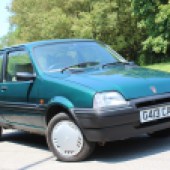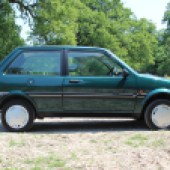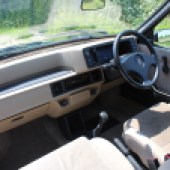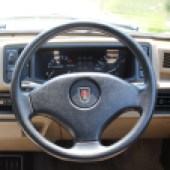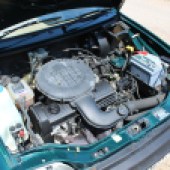The Rover Metro was praised by the press in period when it first arrived – but can a low-mileage survivor still impress today?
Words and images: Jack Grover With thanks to: Beech Hill Garage
The original Austin Metro of 1980 had required all of British Leyland’s stretched resources to get it over the line and into production. The ‘British Car to Beat The World’ wasn’t quite that good, but was certainly a critical and commercial success sufficient to restore a measure of optimism to BL. But the Metro was a car with wrinkles, speaking of the lengthy development time and limited budgets given to it – technically it still owed much to the Mini, and while it was up to snuff in the supermini class of 1980 after just five years it had been left behind.
BL had hopes for a genuinely all-new, technically advanced small car to replace the Metro but, with BL being prepped for privatisation and then coming into the hands of British Aerospace, funding was never made available. The consolation prize was funding for a thorough re-engineering of the Metro which resulted in something that was as much of a new car as it could be without actually being one.
Although the basic body structure was retained, everything else was changed or updated – a new engine (K-Series, also salvaged from the proposed all-new car), new transmission, restyled body, updated interior, revised suspension and almost uncountable detail changes. With the Austin marque retired in 1987, and reflected its more upmarket and high-quality aspirations, the new car emerged as the Rover Metro in late 1989.

Looking back from our lofty, supposedly superior vantage point in 2023, the Rover Metro is generally thought of as a bit of a joke. To a certain generation it will be most famous as the car that Alan Partridge refused to drive, even at the cost of having to sack all his employees in order to get behind the wheel of a Rover 200. To many others, it will mostly be remembered in its final Rover 100 form, with the high-speed film footage of the first NCAP safety tests (and the 100’s dismally crumpled state after them) seared on the national consciousness. That leaves the Rover Metro in a curious hinterland – not the original Austin Metro, which has been somewhat rehabilitated, and not the rare and rather infamous 100. Just the facelift of an old car that wasn’t cutting edge when it was new and now had to carry the weight and expectations of the Rover badge.
This is at odds with how the Rover Metro was actually treated when it was new, and what the ‘buzz’ would have been when this very early G-reg example from the first full year of production left the Lex Mead showroom in Maidenhead. Autocar wrote of giving the Rover Metro a ‘standing ovation’ and pondered whether Rover, fresh from the all-round excellence of the ‘R8’ 200 series, had acquired the Midas Touch. The same publication rated it superior to its Ford, Peugeot and Fiat equivalents and pegged the GTi 16V model as the ‘car to beat’ in its class. What Car? named it Car of the Year for 1991 once the full range had been introduced.
This 1.4SL – for sale at Beech Hill Garage at time of writing – hails from the Metro’s salad days and in many ways is still in them, since it shows just 6520 miles – a barely run-in mileage confirmed by a full stack of MoT certificates and full service history (such as it is for a car with such little use). Fully describing the condition would be a waste of words, since it is exactly as a car with a four-figure mileometer reading should be. It goes without saying that the Metro has been only lightly used, but it has been regularly used and kept in roadworthy condition. It hasn’t been sat without turning a wheel for the past 30-odd years.

That said, it has of course spent the vast majority of its time ‘idle’, but that has been in a garage, sparing it the effects of weather and sunlight – the latter can be especially cruel to 1990s Rover interiors. As a mark of the car’s originality, it still wears its original Dunlop SP tyres, and because they’ve been almost always indoors since 1990 they are not cracked or hard. The lack of ultraviolet light is probably also behind why, despite its age, the headlining is still firmly attached to the roof and has not turned into a tent like most of the others installed in Longbridge, Castle Bromwich or Solihull in the 1990s.
As launched, Rover Metro range wasn’t quite as comprehensive as it would later become, and the SL spec seen here was the entry level to the 1.4-litre models (more luxurious 1.1s and more basic 1.4s would come later). Of course, this being the world of small cars in the early 1990s you’ll hardly mistake it for a Mercedes S-Class – the SL badge got you velour-texture seats and door trims, full floor carpeting, a radio/cassette, internally adjustable (but still manual) wing mirrors and central locking. Being a 1.4 it also came as standard with a tachometer and what was probably the thing that most Metro buyers appreciated, a five-speed gearbox.
The K-Series powertrain in the new Metro was a technical gem but it was the fact that it banished the Metro’s transmission-in-sump arrangement, inherited from the Mini, that yielded the biggest improvements. The K-Series was inherently smoother and both more capable and more willing than the venerable A-Series, but the end-on transmission opened up the possibility of the five forward gears that people had been asking for in a Metro since 1980. The two lowest trim levels of the 1.1 Metro came with a new four-speed ‘box with the five-speed as an option, but all the 1.4s had the five-speed unit.
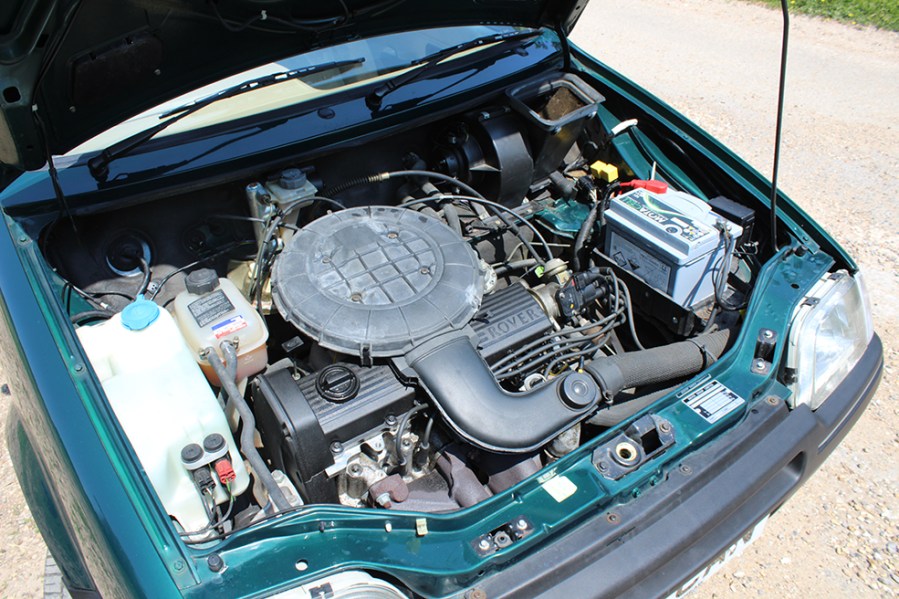
This effectively, if belatedly, brought the Metro into the modern age. But before you can experience it you have to deal with something that puts it firmly in classic territory – a choke. Not at all unusual for the Austin Metro or Mini owner, but it feels particularly odd to be sat in such a decidedly 1990s interior as a Rover Metro and fire up such a modern engine as the K-Series (still in production within the last decade) with a choke. But electronic injection was still filtering down into the world of small cars in 1990 and the Metro range only had it as standard on the GTi models, with it being optional (and an expensive option) elsewhere in the range. Of course, within a few years the introduction of the Euro emissions rules would see the fitment of injection and catalytic converters across the range.
But for now you start the all-alloy, lightweight, through-bolt overhead-cam K-Series exactly like an A-Series – full choke, turn the key, it catches on the third compression stroke, push the choke half way in and get a smooth 1100rpm idle. On a hot, sunny day the K-Series warms up quickly and then the choke can be forgotten about – once up to temperature there is no real difference between how the carburettor and injected engines drive.
One of the other key developments with the Rover Metro was less visible but quickly discerned – the interconnection of the Hydragas units on each side, as per every other car made with Alex Moulton’s suspension systems but eliminated from the original Metro on cost grounds. The interconnection serves to eliminate pitching and ‘chop’ from small-wheeled, short-wheelbase cars, and therefore it is unsurprising that the Austin Metro was both pitchy and choppy. In Rover form, you only have to go a few hundred yards to realise the scale of the improvement.
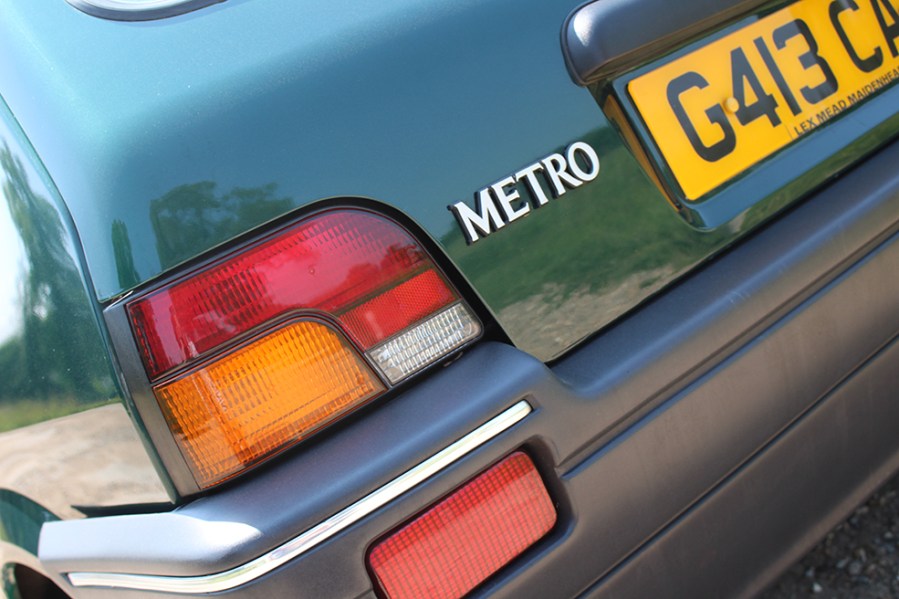
This Metro’s Hydragas has been recently pumped up, so it is sitting at the correct ride height (actually looking surprisingly pert compared to how you tend to see them today). I would venture that there is perhaps slightly too much ‘Hydra’ and not enough ‘gas’ in the system now and that ideally the displacers need rebuilding and re-gassing; the Metro’s ride is slightly on the stiff side. But it’s much better than the fidgety ride of an Austin Metro and leagues better than a ‘dry cone’ Mini.
In terms of body control, especially in pitch, the Metro really does ride like a car twice its size – which is what every road tester in 1990 praised it to the hilt for. The steering shows its Mini heritage being quick, progressive, accurate and sensitive. The engine is as sweet as a nut – perhaps not quite as chronometer-like as the short-stroke 1.1, but tractable and smooth from idle until well up in its rev range. Weighing about 850kg, performance is brisk (the standard Metro 1.4 has similar power and acceleration to the MG Metro of the previous decade) and the Metro is simply fun to drive thanks to its small size, smooth engine, fantastic steering and good roadholding.
Rover Metro 1.4SI: our verdict
As a classic, the value of this Metro is in its low mileage and its condition. Which really does mean it’s future is best as a show car – even letting the mileage roll over to five figures would be a rather sad moment. But if you are brave enough to actually run up the miles in this car, it would make a fantastic runabout.


